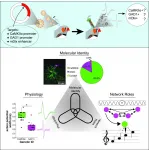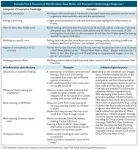(Press-News.org) CHICAGO --- For men physicians, the professional perks of networking on social media, like being asked to give a talk, are abundant, a new Northwestern Medicine study reports.
For women physicians, the benefits are far less plentiful, the study found.
What's more, women physicians are more than twice as likely to be sexually harassed on social media than men physicians, according to an earlier study, published in January, of this same group of study participants.
The findings mirror the struggles women physicians face in person when trying to advance their careers, said first author Nicole Woitowich, research assistant professor of medical social sciences at Northwestern University Feinberg School of Medicine.
"There's been this line of thinking that social media can be used to level the playing field and give women equal opportunities, but it turns out the same biases that promote men are occurring online as well," Woitowich said. "Women are not reaping the benefits of social media, and they're doing so in the face of more online harassment."
The study will be published May 13 in the journal JAMA Network Open.
"Our study makes it even more clear that it is necessary to be intentional in how we engage on social media, and the importance of amplifying women, minorities and those with intersectional identities," said senior author Dr. Shikha Jain, a hematologist and oncologist at University of Illinois Chicago. "There are many benefits that can come from engaging online, as has been shown in other studies, but pitfalls that exist in the real world are just as prevalent in the digital space."
The data also suggest these gender biases may be occurring in other, nonmedical, fields that are traditionally dominated by men, which is worrisome, as a majority of interpersonal interactions have shifted online during the pandemic, Woitowich said.
'I use social media to ...'
In the study, "Gender Differences in Physician Use of Social Media for Professional Advancement," 577 participants completed a survey the study authors sent via traceable links on Twitter between Feb. 6 and March 20, 2019.
Participants could choose to identify as "female," "male," "non-binary/third gender" and "prefer to self-describe." No respondents identified as "non-binary/third gender" or "prefer to self-describe." Anyone who identified as "prefer not to say" were excluded from further analysis.
The survey asked respondents to answer if they agreed or disagreed with questions such as "social media has increased my collaborators with individuals at other institutions," "social media has directly led to a speaking opportunity or engagement" and "social media has resulted in a scholarship opportunity."
While both men and women physicians said that they have expanded their professional network through social media, men were more likely to receive requests to give talks (39% of men respondents versus 30% of women respondents) and participate in other scholarly activities (25% of men versus 21% of women) than women.
While men in the study reported being more likely to use social media for research and educational purposes (83% of men versus 68% of women), women in the study said they were motivated to use social media for additional social support (73% of women versus 55% of men). Woitowich said this is likely because men in academic medicine do not face the same levels of sexual and verbal harassment and gender discrimination as women and thus don't need an outlet to seek advice and counsel from their same-gendered peers.
"We did not address this in our survey, but it may be likely that women also use social media to voice and address these gender inequities," Woitowich said. "Simply put, women physicians may not be afforded the luxury of browsing social media solely for scholarly purposes."
"There are strategies and solutions to ensure these inequities do not persist," Jain said. "Groups such as Women of Impact and the Women in Medicine Summit have created strategic social media amplifiers to lift up the voices of those that are often underrepresented. Others, such as IMPACT and Dear Pandemic, have leveraged social media to collaboratively lift up the voices of women experts while also becoming trusted resources during the COVID-19 pandemic."
INFORMATION:
Other Northwestern study authors include Dr. Seth Trueger, assistant professor of emergency medicine at Feinberg, and Tricia Pendergrast, a medical student at Feinberg. Other authors include Dr. Michael Gottlieb from Rush University Medical Center and Dr. Vineet Arora from the University of Chicago.
New research led by the University of Kent has found that adolescents and older adults pay less attention to social cues in real-world interactions than young adults.
The findings published by Nature Human Behaviour show that social attention undergoes age-related change, which has potential implications for how successfully we can interpret social interactions in daily life and throughout the lifespan.
Interpreting the facial expression, tone of voice and gestures of others is a vital element of social interaction that allow us to make rapid inferences about others' mental states, such as their intentions, emotions, desires and beliefs. Successful social interaction prompts perspective-taking and empathy along with other essential ...
Multiple studies have shown that African American women with breast cancer have lower survival rates than white women with the disease. But the association between race or ethnicity and treatment outcomes in triple-negative breast cancer -- an aggressive type of tumor that does not respond to hormonal or other targeted therapies -- has not been well defined.
Now, new research from Washington University School of Medicine in St. Louis shows that non-Hispanic African American women with triple-negative breast cancer also do not fare as well as non-Hispanic white women with this type of breast cancer. The study demonstrates the need for additional research to address disparities in cancer care and understand whether tumor biology or nonbiological reasons such as systemic racism -- ...
University of Massachusetts Amherst neuroscientists examining genetically identified neurons in a songbird's forebrain discovered a remarkable landscape of physiology, auditory coding and network roles that mirrored those in the brains of mammals.
The research, published May 13 in Current Biology, advances insight into the fundamental operation of complex brain circuits. It suggests that ancient cell types in the pallium - the outer regions of the brain that include cortex - most likely retained features over millions of years that are the building blocks for advanced cognition in birds and mammals.
"We as neuroscientists are catching on that birds can do sophisticated things and they have sophisticated circuits to do those things," ...
The Antarctic ice sheet was even more unstable in the past than previously thought, and at times possibly came close to collapse, new research suggests.
The findings raise concerns that, in a warmer climate, exposing the land underneath the ice sheet as it retreats will increase rainfall on Antarctica, and this could trigger processes that accelerate further ice loss.
The research is based on climate modelling and data comparisons for the Middle Miocene (13-17 million years ago) when atmospheric carbon dioxide and global temperatures reached levels similar to those expected by the end of this century.
The study was carried out by ...
A new discovery led by Princeton University could upend our understanding of how electrons behave under extreme conditions in quantum materials. The finding provides experimental evidence that this familiar building block of matter behaves as if it is made of two particles: one particle that gives the electron its negative charge and another that supplies its magnet-like property, known as spin.
"We think this is the first hard evidence of spin-charge separation," said Nai Phuan Ong, Princeton's Eugene Higgins Professor of Physics and senior author on the paper published this week in the journal Nature Physics.
The experimental results fulfill a prediction made decades ago to explain one of the most mind-bending states ...
The chemical compound glyphosate, the world's most widely used herbicide, can weaken the immune systems of insects, suggests a study from researchers at the Johns Hopkins Bloomberg School of Public Health. Glyphosate is the active ingredient in Round Up™, a popular U.S. brand of weed killer products.
The researchers investigated the effects of glyphosate on two evolutionarily distant insects, Galleria mellonella, the greater wax moth, and Anopheles gambiae, a mosquito that is an important transmitter of malaria to humans in Africa. They found that ...
People who work nontraditional work hours, such as 11 p.m.-7 p.m., or the "graveyard" shift, are more likely than people with traditional daytime work schedules to develop a chronic medical condition -- shift work sleep disorder -- that disrupts their sleep. According to researchers at the University of Missouri, people who develop this condition are also three times more likely to be involved in a vehicle accident.
"This discovery has many major implications, including the need to identify engineering counter-measures to help prevent these crashes from happening," said Praveen Edara, department chair and professor of civil and environmental ...
Writing in the New England Journal of Medicine, a trio of science communication researchers proposes to treat the Covid-19 misinformation "infodemic" with the same methods used to halt epidemics.
"We believe the intertwining spreads of the virus and of misinformation and disinformation require an approach to counteracting deceptions and misconceptions that parallels epidemiologic models by focusing on three elements: real-time surveillance, accurate diagnosis, and rapid response," the authors write in a Perspective article.
"The word 'communicable' comes from the Latin communicare, ...
New research led by the University of Kent has found that people fail to recognise the role of factory farming in causing infectious diseases.
The study published by Appetite demonstrates that people blame wild animal trade or lack of government preparation for epidemic outbreaks as opposed to animal agriculture and global meat consumption.
Scientists forewarned about the imminence of global pandemics such as Covid-19, but humankind failed to circumvent its arrival. They had been warning for decades about the risks of intensive farming practices for public health. The scale of production and overcrowded conditions on factory farms make it easy for viruses to migrate and spread. Furthermore, ...
HOUSTON - Cytokine-activated natural killer (NK) cells derived from donated umbilical cord blood, combined with an investigational bispecific antibody targeting CD16a and CD30 known as AFM13, displayed potent anti-tumor activity against CD30+ lymphoma cells, according to a new preclinical study from researchers at The University of Texas MD Anderson Cancer Center.
The findings were published today in Clinical Cancer Research, a journal of the American Association for Cancer Research. These results led to the launch of a Phase I clinical trial to evaluate the combination of cord blood-derived NK cells (cbNK cells) with AFM13 as an experimental cell-based immunotherapy in patients with CD30+ lymphoma.
"Developing novel NK cell therapies has been a priority for my ...





